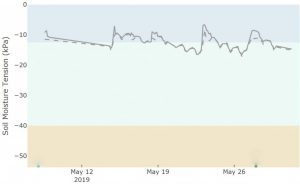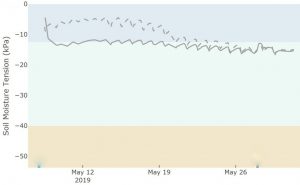We’re hitting a critical peak demand for water in our corn crop, and needing moisture in other crops. I’m working with moisture sensors in corn and pecan trees this year. Using sensors to irrigate can help take some of the guess work out of knowing when to irrigate.
70 day old corn uses .32 inches of water per day. If you were applying .4 to .5 inches with a pivot it would need to run every 22 hours to keep up with water demand, or about 1 inch every 2 days depending on soil types. These numbers are based on a Tifton sand loamy soil and rooting depth of 1.75 feet. The average rooting depth of corn for irrigation is 2 to 4 feet, so I used 1.75 feet in the calculations to be on the safe side. Fields can vary, but the important message is if you are trying to push yields, keeping up with irrigation can be difficult.
The above picture is a screenshot from a soil moisture sensor in field corn. Every blue arrow is when it was irrigated or received rain. Generally, irrigation is started when moistures reaches -25. 0 is saturated and -40 is dry. We prefer to keep the moisture level in the light blue area all season long. You can see how the moisture level responded after each irrigation event. The solid line is at 6 inches deep and the dotted line is 14 inches deep. What’s interesting is around May 22nd it became very difficult to apply enough water for the moisture level at 14 inches to return to the adequate level (red arrow). In this case, we simply have to irrigate based on the 6 inch depth sensor and move on. Every irrigation .75 to 1 inch is being applied, and it would be difficult to apply more, and likely would result in runoff. You can also see that each irrigation only lasts about 2 to 3 days before another one is needed.
The below picture is from a sensor in some 20 year old pecan trees.
Again, the blue arrows show when irrigation occurred. You can see how quickly moisture declines. After irrigating it only takes about 2 days and it’s time to irrigate again. In this same orchard I have two other sensors in some 80 year old trees. Below is a screen shot from that sensor.

The soil type doesn’t vary much. The only difference is water demand. Surprisingly, the 20 year old trees are seemingly demanding more water than the much larger 80 year old trees. You can see in the graph that the moisture level never drops below about -12. Granted, the irrigation does run more often in the older trees than in the younger trees which does impact the soil moisture, but you can see that the moisture level doesn’t drop very low before going back up. Irrigation could be reduced a little based on what the sensors are showing.
Below, in another part of the orchard in some more 80 year old trees we see similar results. This is a lower area that stays a little more wet. We’ll continue to monitor this throughout the season and see how it changes. It is clear that soil moisture sensors can help schedule irrigation even in pecan orchards. More about this will be discussed at the Southeast Georgia pecan Field Day August 28, 2019.


